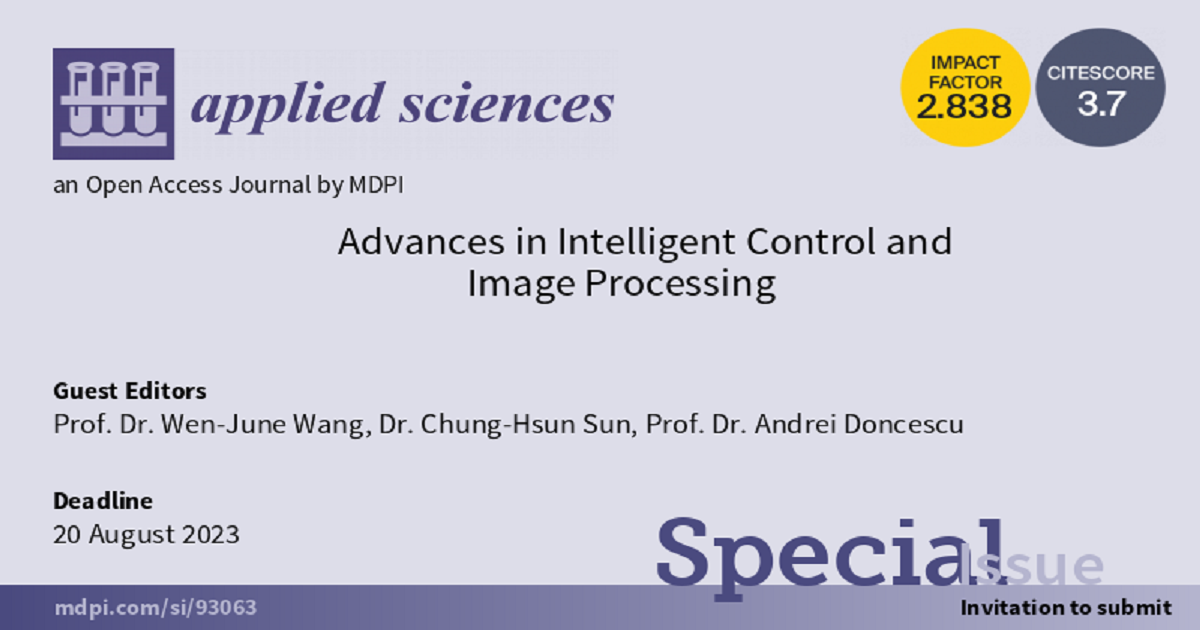Advances in Intelligent Control and Image Processing
A special issue of Applied Sciences (ISSN 2076-3417). This special issue belongs to the section "Computing and Artificial Intelligence".
Deadline for manuscript submissions: closed (20 August 2023) | Viewed by 77342

Special Issue Editors
Interests: fuzzy theory and application; neural network; robot; image processing
Interests: intelligent control and system; robot; computer vision
Interests: image processing; bioinformatics; AI
Special Issues, Collections and Topics in MDPI journals
Special Issue Information
Dear Colleagues,
Due to the rapid development of intelligent technologies in recent years, intelligent control, image processing, computer vision, and AI-based methods have gained many applications in various fields. Numerous cutting-edge studies can be allowed through combining the aforementioned technologies. Intelligent control is a class of control theory that uses artificial intelligence, knowledge-based systems, and smart algorithms for dealing with complex problems. These techniques still have the potential for development and a big impact in many fields of engineering.
This Special Issue highlights innovative research and applications, addresses the problems related to intelligent control, image processing, and computer vision, and also investigates widespread intelligent systems and techniques, such as fuzzy logic, neural networks, and evolutionary algorithms. Novel contributions based on (but not limited to) the following topics are welcome.
- Intelligent control, techniques, and applications;
- Soft computing (fuzzy logic, neural networks, evolutionary approaches);
- Image processing, computer vision, and their applications;
- Robotics and its applications.
Prof. Dr. Wen-June Wang
Dr. Chung-Hsun Sun
Prof. Dr. Andrei Doncescu
Guest Editors
Manuscript Submission Information
Manuscripts should be submitted online at www.mdpi.com by registering and logging in to this website. Once you are registered, click here to go to the submission form. Manuscripts can be submitted until the deadline. All submissions that pass pre-check are peer-reviewed. Accepted papers will be published continuously in the journal (as soon as accepted) and will be listed together on the special issue website. Research articles, review articles as well as short communications are invited. For planned papers, a title and short abstract (about 250 words) can be sent to the Editorial Office for assessment.
Submitted manuscripts should not have been published previously, nor be under consideration for publication elsewhere (except conference proceedings papers). All manuscripts are thoroughly refereed through a single-blind peer-review process. A guide for authors and other relevant information for submission of manuscripts is available on the Instructions for Authors page. Applied Sciences is an international peer-reviewed open access semimonthly journal published by MDPI.
Please visit the Instructions for Authors page before submitting a manuscript. The Article Processing Charge (APC) for publication in this open access journal is 2400 CHF (Swiss Francs). Submitted papers should be well formatted and use good English. Authors may use MDPI's English editing service prior to publication or during author revisions.
Keywords
- intelligent control
- image processing
- computer vision
- engineering applications
Benefits of Publishing in a Special Issue
- Ease of navigation: Grouping papers by topic helps scholars navigate broad scope journals more efficiently.
- Greater discoverability: Special Issues support the reach and impact of scientific research. Articles in Special Issues are more discoverable and cited more frequently.
- Expansion of research network: Special Issues facilitate connections among authors, fostering scientific collaborations.
- External promotion: Articles in Special Issues are often promoted through the journal's social media, increasing their visibility.
- Reprint: MDPI Books provides the opportunity to republish successful Special Issues in book format, both online and in print.
Further information on MDPI's Special Issue policies can be found here.







